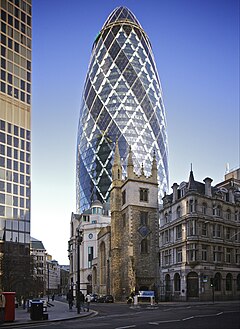30 St Mary Axe
| 30 St Mary Axe | |
|---|---|

30 St Mary Axe, with St Andrew Undershaft church in the foreground, pictured from Leadenhall Street
|
|
| Alternative names | The Gherkin |
| General information | |
| Status | Complete |
| Type | Office |
| Architectural style | Neo-futuristic |
| Location |
St Mary Axe, London, EC3 United Kingdom |
| Coordinates | 51°30′52″N 00°04′49″W / 51.51444°N 0.08028°WCoordinates: 51°30′52″N 00°04′49″W / 51.51444°N 0.08028°W |
| Construction started | 2001 |
| Completed | 2003 |
| Opening | 28 April 2004 |
| Cost | £138 million (plus land cost of £90.6 million) adjusted for inflation: £206 million (plus land cost of £144 million) |
| Height | |
| Roof | 180 metres (591 ft) |
| Technical details | |
| Floor count | 41 |
| Floor area | 47,950 square metres (516,100 sq ft) |
| Design and construction | |
| Architect | Foster and Partners |
| Structural engineer | Arup |
| Main contractor | Skanska |
| References | |
30 St Mary Axe (informally known as The Gherkin and previously as the Swiss Re Building) is a commercial skyscraper in London's primary financial district, the City of London. It was completed in December 2003 and opened in April 2004. With 41 storeys, it is 180 metres (591 ft) tall and stands on the former sites of the Baltic Exchange and Chamber of Shipping, which were extensively damaged in 1992 by the explosion of a bomb placed by the Provisional IRA in St Mary Axe, the street from which the tower takes its name.
After plans to build the 92-storey Millennium Tower were dropped, 30 St Mary Axe was designed by Norman Foster and Arup Group and it was erected by Skanska, with construction commencing in 2001.
The building has become a recognisable feature of London and is one of the city's most widely recognised examples of contemporary architecture.
The building stands on the former sites of the Baltic Exchange (24-28 St Mary Axe), the headquarters of a global marketplace for ship sales and shipping information, and the Chamber of Shipping (30-32 St Mary Axe). On 10 April 1992 the Provisional IRA detonated a bomb close to the Exchange, causing extensive damage to the historic building and neighbouring structures.
The United Kingdom government's statutory adviser on the historic environment, English Heritage, and the City of London's governing body, the City of London Corporation, were keen that any redevelopment must restore the Baltic Exchange's old façade onto St Mary Axe. The Exchange Hall was a celebrated fixture of the ship trading market.
...
Wikipedia
